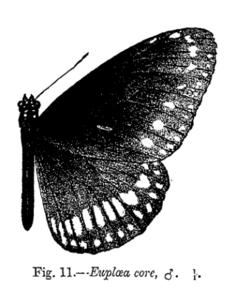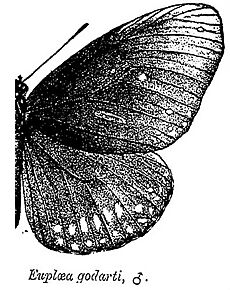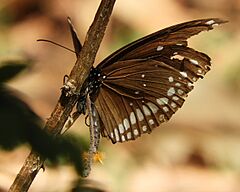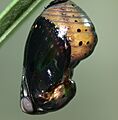Common crow facts for kids
Quick facts for kids Common crow |
|
|---|---|
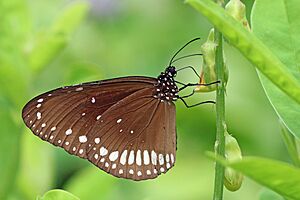 |
|
| E. c. core Kumarakom, Kerala |
|
| Conservation status | |
| Scientific classification | |
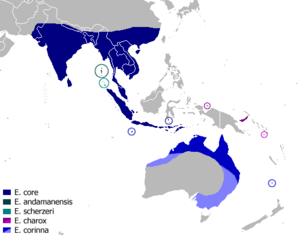 |
The Euploea core, also known as the common crow, is a butterfly often seen from South Asia all the way to Australia. In India, people sometimes call it the common Indian crow, and in Australia, it's known as the Australian crow. It belongs to a group of butterflies called crows and tigers, which are part of the Danainae subfamily.
This butterfly is a shiny black, medium-sized insect, usually about 85-95 millimeters (3.3-3.7 inches) wide. It has rows of white spots along the edges of its wings. The common crow is a slow and steady flyer. It often glides through the air with little effort. This is because it tastes bad to predators. As caterpillars, these butterflies eat plants that contain toxins. These toxins stay in their bodies from the caterpillar stage to the adult butterfly.
When it feeds, the common crow is quite bold and takes its time at each cluster of flowers. You might also see it gathered with other butterflies, drinking water from wet ground, a behavior called mud-puddling. Male common crows visit certain plants like Crotalaria and Heliotropium. They do this to collect special chemicals called pheromones, which they use to attract female butterflies during courtship.
The common crow is the most common type of butterfly in its group, Euploea. Like the tiger butterflies (genus Danaus), crows are not tasty to eat. Because of this, other butterflies that are tasty pretend to be crows to avoid being eaten. This is called Batesian mimicry. Also, different types of crow butterflies in India look similar to each other. This is another kind of mimicry called Müllerian mimicry. Because of these interesting behaviors, scientists have studied the common crow more than other butterflies in its group.
Contents
What the Common Crow Looks Like
The common crow butterfly is mostly shiny black. Its underside is brown with white marks along the outer edges of both wings. Its wingspan is usually about 8 to 9 centimeters (3.1 to 3.5 inches). Its body also has clear white spots.
Male common crows have a velvety black patch near the back edge on the top side of their front wing. On the underside of the wing, there is a white stripe in the same spot. Both male and female butterflies have this white stripe. When the butterfly is resting, this stripe is hidden behind the back wing. You can only see it if you catch the butterfly and look closely.
Different Types of Common Crows
There are many different types, or subspecies, of the common crow butterfly. Some examples include:
- E. c. amymone
- E. c. andamanensis – found in the Andaman Islands
- E. c. asela – found in Sri Lanka, with very small spots
- E. c. core – found in North India, where spots are usually similar in size
- E. c. scherzeri – known as the Nicobar crow
- E. c. vermiculata – found in India, with spots on the front wing that get bigger towards the tip
How Common Crows Copy Other Butterflies
Because the Euploea core butterfly tastes bad, some butterflies that are tasty pretend to be it. This helps them avoid being eaten by predators. This trick is called Batesian mimicry. Also, several other butterflies that also taste bad look similar to each other. This forms a "Mullerian ring," where they all benefit from looking alike.
Here are some butterflies that copy the common crow:
- The Malabar raven (Papilio dravidarum)
- The common mime (Papilio clytia)
- The female great eggfly (Hypolimnas bolina)
You can tell them apart by looking closely:
 |
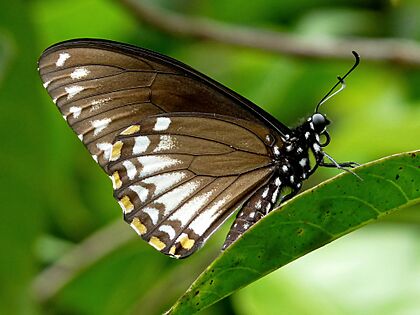 |
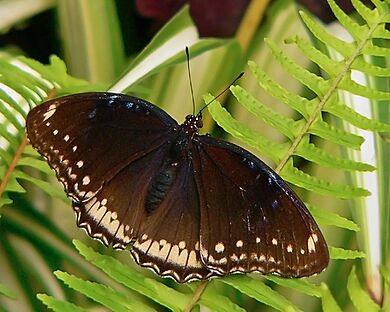 |
| Malabar raven (Papilio dravidarum) | Common mime (Papilio clytia) | Great eggfly (Hypolimnas bolina) female |
|
|
|
Where these butterflies live also helps tell them apart. The Malabar raven and common mime usually live in forests. The common mime is found in all forested areas in India, but the Malabar raven only lives in the Western Ghats region.
Other crow butterflies that taste bad also look similar to each other:
- Brown king crow (E. klugii)
- Double branded crow (E. sylvester)
These butterflies are very similar. You would need to catch them and look closely at their wing patterns to tell them apart.
Where Common Crows Live and What They Do
You can find the common crow butterfly in many places, including southern Pakistan, Sri Lanka, India, Bangladesh, Myanmar, Russia, and Australia.
These butterflies live everywhere, from sea level up to mountains as high as 8,000 feet (2,400 meters). They can be seen in all kinds of plants and in all types of areas, from dry lands to thick forests. You might see them gliding over the tops of trees or flying just a foot off the ground, looking for flowers to drink from. In dense forests, they often fly along open paths or follow rivers.
Since they are protected by their bad taste, common crows fly in a relaxed way. They often fly around bushes and shrubs, looking for plants where they can lay their eggs. They visit many different kinds of flowering plants. When gliding, the common crow holds its wings slightly above flat, keeping its flight with just a few slow wingbeats.
The common crow loves nectar from flowers and takes its time feeding. It seems to prefer groups of flowers rather than single ones. When it's feeding, it's not easily scared away, so you can often get quite close to it.
On hot days, many common crows gather on wet sand to drink water, a behavior called mud-puddling. They often join huge groups with other crow butterflies and similar species.
These butterflies also gather on damaged parts of plants like Crotalaria and Heliotropium. They do this to collect special chemicals called pyrrolizidine alkaloids. These chemicals are used to make pheromones, which help them attract mates.
Like other butterflies in the Danaid group, such as the tigers, the common crow is one of the most common butterflies that migrates. Both male and female butterflies have been seen migrating in equal numbers.
How Common Crows Protect Themselves
The common crow butterfly tastes bad because of chemicals it gets from the plants it eats as a caterpillar. Because of this protection, they fly in a relaxed way, gliding skillfully with their wings held slightly up. This shows predators that they are not good to eat. A new predator might try to attack one, but it will quickly learn to avoid this butterfly. The chemicals in the butterfly's body can make predators sick.
The common crow has tough, leathery wings. If attacked, it pretends to be dead and oozes a liquid that makes predators let go and feel sick. Once released, the butterfly "magically recovers" and flies away. Predators remember this bad experience and learn to stay away from these butterflies.
Life Cycle
-
Caterpillar on Carissa carandas
Eggs
Female common crows lay their eggs on the underside of young leaves of their host plants. The egg is shiny white, tall, and pointed, with ribbed sides. Just before the egg hatches, it turns grayish with a black top.
Caterpillar
The caterpillar stays on the underside of leaves throughout its life. It is round, brightly colored, and smooth. It has white and dark brown or black stripes all over its body. Along its sides, just above its legs, there is a wide orangish-red band with black breathing holes called spiracles. The most noticeable features are its four pairs of long black tentacles. The first pair can move and is the longest. These tentacles are found on the 3rd, 4th, 6th, and 12th body segments. The caterpillar's head is shiny, smooth, and has black and white curved stripes.
The plants that common crow caterpillars eat have poisonous sap (latex). To deal with this, the caterpillar has special eating habits. First, it chews the main vein of the leaf, which stops the flow of sap. Then, it nips a few smaller veins to further block the sap. After that, the caterpillar eats the leaf only where the plant's natural defenses have been turned off. The caterpillar can handle the plant's toxins and stores them in its body fat. This is what makes the adult butterfly taste bad to predators.
Pupa
The pupa (or chrysalis) of this butterfly is shiny golden and compact. The edges of its wings and body segments have wide clear bands. The abdomen has two black spots on each segment. The part that attaches the pupa to a surface is black. Just before the adult butterfly comes out, its black wings can be seen through the pupa's skin. Sometimes, tiny parasitic flies attack these pupae.
What Caterpillars Eat
The common crow caterpillar eats leaves from many different plants. These plants belong to families like:
- Apocynaceae (dogbanes, milkweeds, and oleanders)
- Moraceae (figs)
- Rubiaceae
- Ulmaceae (nettles)
Some of the specific plants they eat include:
- Calotropis gigantea
- Ficus benghalensis (Banyan tree)
- Ficus religiosa (Peepal tree)
- Nerium oleander (Oleander)
- Plumeria acuminata (Frangipani)
They often prefer certain plants in different areas. The most commonly used plants are Ficus racemosa, Nerium oleander, and Cryptolepis buchananii. They have also been seen on Ficus pumila, a garden plant that climbs on walls.
See also
- Mimic
- Nymphalidae
- List of butterflies of India
- List of butterflies of India (Nymphalidae)
Images for kids




